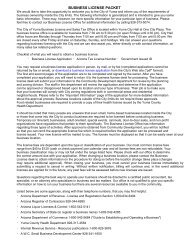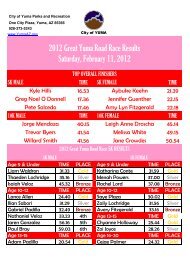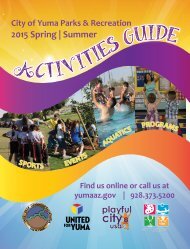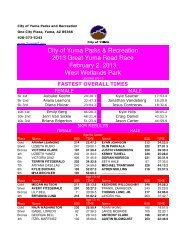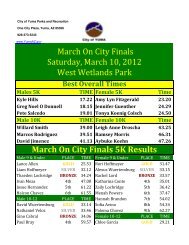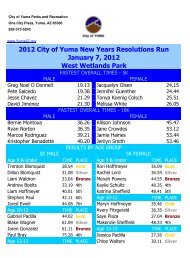Water Quality Report - City of Yuma, Arizona
Water Quality Report - City of Yuma, Arizona
Water Quality Report - City of Yuma, Arizona
- No tags were found...
You also want an ePaper? Increase the reach of your titles
YUMPU automatically turns print PDFs into web optimized ePapers that Google loves.
ANNUALWATER TESTINGPERFORMEDIN 2014WATERQUALITYREPORTPresented ByEste informe contiene información muy importante sobre su agua potable. Tradúzcalo o hable con alguien que lo entienda bien.PWS ID#: AZ0414024
Our Mission ContinuesWe are proud to present once again our annual water quality reportcovering all testing performed between January 1 and December31, 2014. Most notably, last year marked the 40th anniversary <strong>of</strong> theSafe Drinking <strong>Water</strong> Act (SDWA). This rule was created to protectpublic health by regulating the nation’s drinking water supply. Wecelebrate this milestone as we continue to manage our water systemwith a mission to deliver the best-quality drinking water. By striving tomeet the requirements <strong>of</strong> SDWA, we are ensuring a future <strong>of</strong> healthy,clean drinking water for years to come. We are pleased to report that wecontinue to produce high-quality water that meets or exceeds all Federaland State drinking water standards.The Utilities Department instituted monthly billing in June 2014 andcompleted the Automatic Meter Reading (AMR) project in January 2015.Please let us know if you ever have any questions or concerns about yourwater.Sincerely,Jay Simonton, M.P.A.Utilities DirectorWhere Does My <strong>Water</strong> Come From?The main source <strong>of</strong> <strong>Yuma</strong>’s drinking water is surface water from theColorado River. It is delivered to the treatment facilities via the canalsystems. The Main Street Treatment Facility is a conventional surfacewater treatment plant. The Agua Viva <strong>Water</strong> Treatment Facility treatssurface water and groundwater. <strong>Water</strong> drawn from a well is groundwater.Important Health InformationSome people may be more vulnerable to contaminants in drinkingwater than the general population. Immunocompromisedpersons such as those with cancer undergoing chemotherapy,those who have undergone organ transplants, people withHIV/AIDS or other immune system disorders, someelderly, and infants may be particularly at risk frominfections. These people should seek advice aboutdrinking water from their health care providers. TheU.S. EPA/CDC (Centers for Disease Control andPrevention) guidelines on appropriate means to lessenthe risk <strong>of</strong> infection by Cryptosporidium and othermicrobial contaminants are available from theSafe Drinking <strong>Water</strong> Hotline at (800) 426-4791or http://water.epa.gov/drink/hotline.
You’re Invited to Participate in <strong>Yuma</strong>’s <strong>Water</strong> <strong>Quality</strong> FutureThe <strong>City</strong> <strong>of</strong> <strong>Yuma</strong>’s <strong>Water</strong> and Sewer Commission is a group <strong>of</strong> citizens developing ideas and providing adviceto the Utilities Director on a range <strong>of</strong> water and wastewater issues. Our <strong>Water</strong> and Sewer Commission meetson-call at 5:00 p.m. in the Department <strong>of</strong> Public Works Administrative Conference Room. The public is invited.You can contact the Department <strong>of</strong> Public Works at (928) 373-4500 for more information regarding meeting dates.Source <strong>Water</strong> AssessmentIn 2004, the <strong>Arizona</strong> Department <strong>of</strong>Environmental <strong>Quality</strong> completed a sourcewater assessment for the <strong>Yuma</strong> Main Canal,the “A” Main Canal, and groundwater wellsused by the <strong>City</strong> <strong>of</strong> <strong>Yuma</strong>. The Assessmentreviewed the adjacent land uses that may posea potential risk to the sources. The result <strong>of</strong>the Assessment was that adjacent land useposed a low risk to all source water. For acomplete copy <strong>of</strong> the Assessment, contactdml@azdeq.gov, call (602) 771-4641, or visitthe ADEQ’s Source <strong>Water</strong> Assessment andProtection Unit Web site at www.azdeq.gov/environ/water/dw/swap.html.Variances and ExemptionsADEQ or EPA can give permission for a utilitynot to meet an MCL or a treatment techniqueunder certain conditions.The <strong>City</strong> <strong>of</strong> <strong>Yuma</strong> was granted a waiver from theEnhanced Coagulation and Enhanced S<strong>of</strong>teningrules on July 2, 2002, by the <strong>Arizona</strong> Department<strong>of</strong> Environmental <strong>Quality</strong>. The waiver was based ontwo years <strong>of</strong> research performed on <strong>City</strong> <strong>of</strong> <strong>Yuma</strong>water. The data confirmed that the Colorado Riverwater at <strong>Yuma</strong> is not amenable to the requirements<strong>of</strong> the rule. The waiver remains in effect as longas the running annual average (RAA) for totaltrihalomethanes (TTHMs) remains below 0.064ppm, and the RAA for haloacetic acids (HAA5)remains below 0.048 ppm.Lead in Home PlumbingIf present, elevated levels <strong>of</strong> lead can cause serious health problems, especially forpregnant women and young children. Lead in drinking water is primarily frommaterials and components associated with service lines and home plumbing.We are responsible for providing high-quality drinking water, but we cannotcontrol the variety <strong>of</strong> materials used in plumbing components. When yourwater has been sitting for several hours, you can minimize the potential forlead exposure by flushing your tap for 30 seconds to 2 minutes before usingwater for drinking or cooking. If you are concerned about lead in your water,you may wish to have your water tested. Information on lead in drinkingwater, testing methods, and steps you can take to minimize exposure isavailable from the Safe Drinking <strong>Water</strong> Hotline or at www.epa.gov/safewater/lead.QUESTIONS?If you have any questions about this report or the quality <strong>of</strong> ourdrinking water, please contact Betsy Bowman, Laboratory Director,at the Utility Treatment Laboratory, (928) 329-2893.• E-mail address: Betsy.Bowman@yumaaz.gov• <strong>City</strong> <strong>of</strong> <strong>Yuma</strong> Home Page: www.yumaaz.gov• Laboratory Direct Web Page: www.yumaaz.gov/7666.htm• Environmental Protection Agency: (800) 426-4791• <strong>Arizona</strong> Department <strong>of</strong> Environmental <strong>Quality</strong>: (800) 234-5677
The AMR Project Has Been Completed!The <strong>City</strong> <strong>of</strong> <strong>Yuma</strong> Utilities Department reached a significant milestonein January 2015 with the completion <strong>of</strong> an Automated Meter Reading(AMR) Retr<strong>of</strong>itting project. In the early years, reads were visually taken bymeter readers and handwritten in record books. In 1987, the process wasupgraded to manually entering the visual reads into a handheld computer.With AMR, the read is sent by a radio signal from a transmitter attached tothe meter to a receiver that the meter reader carries in the vehicle, resultingin reading in drive-by mode. The project began in September 2006 with anaggressive five-year roll out plan. However, due to the economic decline andbudget constraints, the project continued but at a much slower pace. Now, after8 1/2 years, all 29,648 customer water meters have been outfitted with AMR.AMR provides reading speed to support a demanding reading schedule thatchanged from bi-monthly to monthly in June 2014. The radio-transmittedreads improve accuracy while enhancing meter reader safety. AMR includescustomized reports for examining usage data and prompting meter repairs. Itreduces the number <strong>of</strong> can’t-read situations and works in all weather conditions.AMR provides hourly usage data that can be provided to customers. Thisinformation assists customers with identifying water leaks and gives a meansto point out overwatering, promoting both voluntary leak repairs and waterconservation. Finally, AMR is a lasting product that will grow as the <strong>City</strong> grows,allowing for additional accounts within the existing s<strong>of</strong>tware configuration.AMR IS EFFICIENCY, and the <strong>City</strong> <strong>of</strong> <strong>Yuma</strong> Utilities Department is proud toprovide AMR as the meter-reading method for all <strong>of</strong> our customers.If you have any questions about your water usage and history, contact CustomerService at (928) 373-5076.A water meter is fitted with a transmitter to sendconsumption reading to the meter reader’s computer.
Treatment Train DescriptionThe <strong>City</strong> <strong>of</strong> <strong>Yuma</strong> Main Street <strong>Water</strong> Treatment Facility uses conventional water treatment methods. Rawwater is pretreated with either chlorine gas or chlorine dioxide. Treatment chemicals (alum and polymer) areadded, which cause small particles in the water to adhere to one another (called floc), making them heavy enoughto settle to the bottom <strong>of</strong> the basin. The treated water then flows from the sedimentation basins to the filters.As smaller, suspended particles are removed, turbidity disappears and clear water emerges. Fluoride is added toprevent tooth decay, and chlorine is added for disinfection before the water is distributed in the water system.<strong>Water</strong> from the sedimentation basin flows over a weirThe Agua Viva <strong>Water</strong> Treatment Facility treats both groundwater andsurface water.The Agua Viva <strong>Water</strong> Treatment Facility uses water from a series <strong>of</strong>groundwater wells. Groundwater is extracted from the wells, andiron and manganese are removed. The treated groundwater entersinto storage tanks before disinfection and being distributed in thewater system.The surface water treatment process uses an advance membranetreatment technology. Raw water is sent through a 500-micronscreen, adding alum to coagulate particles, and then sent to themembrane filtration system. After the water passes through themembranes, treated water receives a dose <strong>of</strong> fluoride to prevent toothdecay. Finally, the water enters storage tanks being disinfected anddistributed in the water system.The Agua Viva <strong>Water</strong> Treatment Facility may use surface water,groundwater, or a blend <strong>of</strong> both before distribution in the watersystem.Membrane Filter Display
Substances That Could Be in <strong>Water</strong>To ensure that tap water is safe to drink, <strong>Arizona</strong>Department <strong>of</strong> Environmental <strong>Quality</strong> prescribesregulations limiting the amount <strong>of</strong> certain contaminantsin water provided by public water systems. U.S. Foodand Drug Administration regulations establish limitsfor contaminants in bottled water. Drinking water,including bottled water, may reasonably be expected tocontain at least small amounts <strong>of</strong> some contaminants.The presence <strong>of</strong> these contaminants does not necessarilyindicate that the water poses a health risk.The sources <strong>of</strong> drinking water (both tap water andbottled water) include rivers, lakes, streams, ponds,reservoirs, springs, and wells. As water travels over thesurface <strong>of</strong> the land or through the ground, it dissolvesnaturally occurring minerals, in some cases, radioactivematerial, and substances resulting from the presence<strong>of</strong> animals or from human activity. Contaminants thatmay be present in source water include:Microbial Contaminants, such as viruses and bacteria,which may come from sewage treatment plants, septicsystems, agricultural livestock operations, or wildlife;Inorganic Contaminants, such as salts and metals,which can be naturally occurring or may result fromurban stormwater run<strong>of</strong>f, industrial or domesticwastewater discharges, oil and gas production, mining,or farming;Pesticides and Herbicides, which may come from avariety <strong>of</strong> sources such as agriculture, urban stormwaterrun<strong>of</strong>f, and residential uses;Organic Chemical Contaminants, including syntheticand volatile organic chemicals, which are by-products <strong>of</strong>industrial processes and petroleum production and mayalso come from gas stations, urban stormwater run<strong>of</strong>f,and septic systems;Radioactive Contaminants, which can be naturallyoccurring or may be the result <strong>of</strong> oil and gas productionand mining activities.More information about contaminants in tap waterand potential health effects can be obtained by callingthe Environmental Protection Agency’s Safe Drinking<strong>Water</strong> Hotline at (800) 426-4791 or visit online atwww.epa.gov/safewater/hotline. Information on bottledwater can be obtained from the U.S. Food and DrugAdministration.
Sampling ResultsIn 2014, the <strong>City</strong> <strong>of</strong> <strong>Yuma</strong> conducted all water quality testing required by State and Federal regulations plus many more tests than regulations required. Testing revealed that the <strong>City</strong>’sdrinking water quality met all regulatory standards set to safeguard public health. The data tables below present 2014 test results and corresponding water quality standards. The tablesshow only those contaminants that were detected in the water.The State requires us to monitor for certain substance less <strong>of</strong>ten than once per year because the concentrations <strong>of</strong> substances do not change frequently. In these cases, the most recentsample data are included, along with the year in which the sample was taken.We participated in the 3rd stage <strong>of</strong> the EPA’s Unregulated Contaminant Monitoring Regulation (UCMR3) program by performing additional tests on our drinking water. UCMR3benefits the environment and public health by providing the EPA with data on the occurrence <strong>of</strong> contaminants suspected to be in drinking water, in order to determine if the EPA needsto introduce new regulatory standards to improve drinking water quality. Contact us for more information on this programREGULATED SUBSTANCESSUBSTANCE(UNIT OF MEASURE)YEARSAMPLEDMCL[MRDL]MCLG[MRDLG]Main Street Treatment FacilityAMOUNTDETECTEDRANGELOW-HIGH<strong>City</strong> <strong>of</strong> <strong>Yuma</strong>Distribution SystemAMOUNTDETECTEDRANGELOW-HIGHAgua Viva Treatment FacilityAMOUNTDETECTEDRANGELOW-HIGH VIOLATION TYPICAL SOURCEAlpha Emitters (pCi/L) 2011 15 0 1.3 NA NA NA NA NA No Erosion <strong>of</strong> natural depositsArsenic (ppb) 2014 10 0 2.7 NA NA NA 2.4 NA No Erosion <strong>of</strong> natural deposits; Run<strong>of</strong>ffrom orchards; Run<strong>of</strong>f from glass andelectronics production wastesBarium (ppm) 2014 2 2 0.096 NA NA NA 0.090 NA No Discharge <strong>of</strong> drilling wastes; Dischargefrom metal refineries; Erosion <strong>of</strong>natural depositsChlorine (ppm) 2014 [4] [4] NA NA 1.12 0.11–1.12 NA NA No <strong>Water</strong> additive used to control microbesFluoride (ppm) 2014 4 4 0.49 NA NA NA 0.38 NA No Erosion <strong>of</strong> natural deposits; <strong>Water</strong>additive that promotes strong teeth;Discharge from fertilizer and aluminumfactoriesHaloacetic Acids [HAAs]–Stage2 (ppb)2014 60 NA NA NA 10 5.5–16 NA NA No By-product <strong>of</strong> drinking waterdisinfectionNitrate (ppm) 2014 10 10 0.28 NA NA NA 0.25 NA No Run<strong>of</strong>f from fertilizer use; Leachingfrom septic tanks, sewage; Erosion <strong>of</strong>natural depositsTTHMs [TotalTrihalomethanes]–Stage 2 (ppb)Total Coliform Bacteria (%positive samples)2014 80 NA NA NA 47 28–71 NA NA No By-product <strong>of</strong> drinking waterdisinfection2014 5% <strong>of</strong> monthlysamples arepositive0 NA NA 0.16 NA NA NA No Naturally present in the environmentTurbidity 1 (NTU) 2014 TT NA 0.111 0.030–0.111 NA NA 0.145 0.010–0.145 No Soil run<strong>of</strong>fTurbidity (Lowest monthlypercent <strong>of</strong> samples meeting limit)2014 TT NA 100 NA NA NA 100 NA No Soil run<strong>of</strong>fUranium (ppb) 2011 30 0 2.8 NA NA NA 5.8 NA No Erosion <strong>of</strong> natural deposits
Tap water samples were collected for lead and copper analyses from sample sites throughout the community.SUBSTANCE(UNIT OF MEASURE)YEARSAMPLED AL MCLGAMOUNTDETECTED(90TH%TILE)SITES ABOVEAL/TOTALSITES VIOLATION TYPICAL SOURCECopper (ppm) 2012 1.3 1.3 0.068 0/100 No Corrosion <strong>of</strong> household plumbing systems; Erosion <strong>of</strong> natural depositsLead (ppb) 2012 15 0 0.62 0/100 No Corrosion <strong>of</strong> household plumbing systems; Erosion <strong>of</strong> natural depositsUNREGULATED SUBSTANCESSUBSTANCE(UNIT OF MEASURE)YEARSAMPLEDMain Street TreatmentFacilityAMOUNTDETECTEDRANGELOW-HIGHAgua Viva TreatmentFacilityAMOUNTDETECTEDRANGELOW-HIGHTYPICAL SOURCESodium (ppm) 2014 120 NA 120 NA Naturally present in the environmentUNREGULATED CONTAMINANT MONITORING REGULATION (UCMR3)SUBSTANCE(UNIT OF MEASURE)YEARSAMPLEDMain Street TreatmentFacilityAMOUNTDETECTEDRANGELOW-HIGHAgua Viva Treatment FacilityAMOUNTDETECTEDRANGELOW-HIGHMain Street MaximumResident Sample SiteAMOUNTDETECTEDRANGELOW-HIGHAgua Viva Maximum ResidentSample SiteAMOUNTDETECTEDBromomethane (ppb) 2014 0.066 NA NA NA NA NA NA NAChlorate 2 (ppb) 2014 82 NA 240 NA 110 NA 230 NAChromium [Total] 2 (ppb) 2013 NA NA 0.23 NA NA NA NA NAChromium-6 2 (ppb) 2013 NA NA 0.032 NA NA NA NA NAMolybdenum 2 (ppb) 2014 5.4 NA 5 NA 5.2 NA 4.9 NAStrontium 2 (ppb) 2014 1,100 NA 1,000 NA 1,100 NA 1,000 NAVanadium 2 (ppb) 2014 1.8 NA 1.6 NA 1.7 NA 1.6 NA1Turbidity is a measure <strong>of</strong> the cloudiness <strong>of</strong> the water. We monitor it because it is a good indicator <strong>of</strong> the effectiveness <strong>of</strong> our filtration system.2This substance was part <strong>of</strong> our UCMR3 sampling schedule.RANGELOW-HIGHDefinitionsAL (Action level): The concentration <strong>of</strong> a contaminantthat, if exceeded, triggers treatment or otherrequirements that a community water system shallfollow.MCL (Maximum Contaminant Level): The highestlevel <strong>of</strong> a contaminant that is allowed in drinking water.MCLs are set as close to the MCLGs as feasible usingthe best available treatment technology.MCLG (Maximum Contaminant Level Goal): Thelevel <strong>of</strong> a contaminant in drinking water below whichthere is no known or expected risk to health. MCLGsallow for a margin <strong>of</strong> safety.MRDL (Maximum Residual Disinfectant Level):The highest level <strong>of</strong> a disinfectant allowed in drinkingwater. There is convincing evidence that addition <strong>of</strong>a disinfectant is necessary for control <strong>of</strong> microbialcontaminants.MRDLG (Maximum Residual Disinfectant LevelGoal): The level <strong>of</strong> a drinking water disinfectant belowwhich there is no known or expected risk to health.MRDLGs do not reflect the benefits <strong>of</strong> the use <strong>of</strong>disinfectants to control microbial contaminants.NA: Not applicableNTU (Nephelometric Turbidity Units): Measurement<strong>of</strong> the clarity, or turbidity, <strong>of</strong> water. Turbidity in excess<strong>of</strong> 5 NTU is just noticeable to the average person.pCi/L (picocuries per liter): A measure <strong>of</strong> radioactivity.ppb (parts per billion): One part substance per billionparts water (or micrograms per liter).ppm (parts per million): One part substance permillion parts water (or milligrams per liter).TT (Treatment Technique): A required processintended to reduce the level <strong>of</strong> a contaminant indrinking water.



